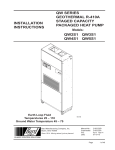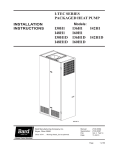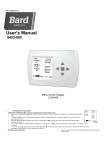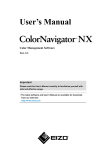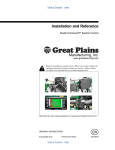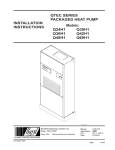Download Bard 920-0074 QWSERV Specifications
Transcript
OPERATION INSTRUCTIONS ENERGY RECOVERY VENTILATOR WITH EXHAUST Models: 920-0074 QWSERV 920-0138 QWSERV with Intelligent Defrost For Use With Bard 2 Through 5 Ton QW*S Series Bard Manufacturing Company, Inc. Bryan, Ohio 43506 Since 1914...Moving ahead, just as planned. Manual:2100-533E Supersedes:2100-533D File: Volume II, Tab 14 Date:04-23-14 Manual2100-533E Page 1 of 12 CONTENTS Electrical Specifications............................................ 3 General Description.................................................. 3 920-0074 & -0138 with Intelligent Defrost................ 3 Control Requirements.............................................. 3 Recommended Control Sequences......................... 4 Control Wiring........................................................... 4 Ventilation Airflow..................................................... 4 Performance & Application Data........................ 5 & 6 Figures Figure 1 Figure 2 Figure 3 Figure 4 Blower Speed Adjustment......................... 4 Belt Replacement...................................... 8 Hub Assembly with Ball Bearings.............. 9 Configuring 8403-067 CO2 Control.......... 12 Wiring Diagram Wiring Diagram for 920-0074 QWSERV................ 10 Wiring Diagram for 920-0138 QWSERV w/I.D....... 11 Tables Table 1 Ventilation Air (CFM)................................. 4 Table 2 Summer Cooling Performance.................. 5 Table 3 Winter Heating Performance..................... 6 Energy Recovery Ventilator Maintenance ......... 6 & 7 Maintenance Procedures ........................................ 7 BARD MANUFACTURING COMPANY, INC. BRYAN, OHIO USA 43506 Manual2100-533E Page 2 of 12 ELECTRICAL SPECIFICATIONS Model Voltage Amps Control Voltage 920-0074 920-0138 230 / 208 2.2 24V Model For Use with the Following Units 920-0074 920-0138 QW2S-A, -B, -C QW3S-A, -B, -C QW4S-A, -B, -C QW5S-A, -B, -C GENERAL DESCRIPTION CONTROL REQUIREMENTS The Energy Recovery Ventilator was designed to provide energy efficient, cost effective ventilation to meet I. A. Q. (Indoor Air Quality) requirements while still maintaining good indoor comfort and humidity control for a variety of applications such as schools, classrooms, lounges, conference rooms, beauty salons and others. It provides a constant supply of fresh air for control of airborne pollutants including CO2, smoke, radon, formaldehyde, excess moisture, virus and bacteria. 1. Indoor blower motor must be run whenever the ERV is run. The ventilator incorporates patented rotary heat exchange state-of-the-art technology to remove both heat & moisture and provides required ventilation to meet the requirements of ASHRAE 62.1 standard. It is designed as a single package which is factory installed. The package consists of a unique rotary Energy Recovery Cassette that can be easily removed for cleaning or maintenance. It has two 15-inch diameter heat transfer wheels for efficient heat transfer. The heat transfer wheels use a permanently bonded dry desiccant coating for total heat recovery. Ventilation is accomplished with 2 blower/motor assemblies each consisting of a drive motor and dual blowers for maximum ventilation at low sound levels. Motor speeds can be adjusted so that air is exhausted at the same rate that fresh air is brought into the structure thus not pressuring the building. The rotating energy wheels provide the heat transfer effectively during both summer and winter conditions. 2. Select the correct motor speed on the ERV. Using Table 1 of the ERV Installation Instructions determine the motor speed needed to get the desired amount of ventilation air needed. For instance, do not use the high speed tap on a ERV if only 200 CFM of ventilation air is needed. Use the low speed tap. Using the high speed tap would serve no useful purpose and would effect the overall efficiency of the heat pump system. System operation costs would also increase. 3. Run the ERV only during periods when the conditioned space is occupied. Running the ERV during unoccupied periods wastes energy, decreases the expected life of the ERV, and can result in a large moisture buildup in the structure. The ERV can remove up to 60 to 70% of the moisture in the incoming air, not 100% of it. Running the ERV when the structure is unoccupied allows moisture to build up in the structure because there is little or no cooling load. Thus, the air conditioner is not running enough to remove the excess moisture being brought in. Use a control system that in some way can control the system based on occupancy. NOTE:The Energy Recovery Ventilator is NOT a dehumidifier. NOTE:Operation is not recommended below 5°F outdoor temperature because freezing of moisture in the heat transfer wheel can occur. 920-0138 WITH INTELLIGENT DEFROST This model is equipped with a thermostat which is sensing the intake ventilation air. It is factory set to initiate a defrost sequence when operations are below 10°F. This defrost time is set for a 4-minute defrost for every 32 minutes of ERV operation. This control circuit controls the intake damper assembly allowing the ERV to operate with zero intake air to allow conditioned room air to defrost the cassette wheels. IMPORTANT Operating the ERV during unoccupied periods can result in a build up of moisture in the classroom. Manual2100-533E Page 3 of 12 RECOMMENDED CONTROL SEQUENCES Several possible control scenarios are listed below: 1. Use a programmable electronic thermostat with auxiliary terminal to control the ERV based on daily programmed occupancy periods. Bard markets and recommends Bard Part No. 8403-060 programmable electronic thermostat for heat pump applications. 2. Use a motion sensor in conjunction with a mechanical thermostat to determine occupancy in the classroom. Bard markets the CS2000A for this use. 3. Use a DDC control system to control the ERV based on a room occupancy schedule. 4. Tie the operation of the ERV into the light switch. The lights in a room are usually on only when occupied. 5. Use a manual timer that the occupants turn to energize the ERV for a specific number of hours. 6. Use a programmable mechanical timer to energize the ERV and indoor blower during occupied periods of the day. 7. Use Bard Part No. 8403-056 CO2 controller for “ondemand” ventilation. CONTROL WIRING The QWSERV comes wired in the low voltage control circuit from the factory. With the “X” Remote Thermostat Option, it is default wired into the “A” terminal, which drives the vent to operate only during occupied periods when using a Bard 8403-060 or CS9B Series thermostats. If you prefer for the QWSERV to operate anytime the blower is operational, you will need to install a jumper wire from “G” to “A”. If you prefer to use Bard 8403-067 CO2 controller to make the ventilation “on-demand”, there is a connection adjacent to the thermostat connections in the unit upper right-hand corner, and is marked to match CO2 controller connections. Furthermore, you will need to field set the CO2 sensor jumpers per Figure 4. With the “D” Door Mounted Thermostat Option, the thermostat is already connected and programmed to operate the QWSERV only during occupied periods. With the “H” Door Mounted Thermostat and CO2 controller, the unit is ready to go with “on-demand” ventilation as controlled by the CO2 controller. Manual2100-533E Page 4 of 12 VENTILATION AIRFLOW The ERV is equipped with a 3-speed motor to provide the capability of adjusting the ventilation rates to the requirements of the specific application by simply changing motor speeds. TABLE 1 VENTILATION AIR (CFM) CFM High Speed (Black) Medium Speed (Blue) Low Speed (Red) 450 375 300 The ERV units are wired from the factory on medium intake and low exhaust speeds. The ERV is equipped with independently controlled 3-speed motor to provide the capability of adjusting the ventilation rates to the requirements of the specific application and to be able to provide positive pressure in the structure. This is accomplished by setting the intake blower on a higher speed than the exhaust blower. WARNING Open disconnect to shut all power OFF before doing this. Failure to do so could result in injury or death due to electrical shock. Moving the speed taps located in the control panel can change the blower speed of the intake and exhaust. See Figure 1. FIGURE 1 BLOWER SPEED ADJUSTMENT PERFORMANCE AND APPLICATION DATA TABLE 2 SUMMER COOLING PERFORMANCE (INDOOR DESIGN CONDITIONS 75°DB/62°WB) Ambient O.D. DB/WB 105 100 95 90 85 80 75 VENTILATION RATE 450 CFM 65% EFFICIENCY VENTILATION RATE 375 CFM 66% EFFICIENCY VENTILATION RATE 300 CFM 67% EFFICIENCY F VLT VLS VLL HRT HRS HRL VLT VLS VLL HRT HRS HRL VLT VLS VLL HRT HRS HRL 75 21465 14580 6884 13952 9477 4475 17887 12150 5737 11805 8018 3786 14310 9720 4590 9587 6512 3075 70 14580 14580 0 9477 9477 0 12150 12150 0 8018 8018 0 9720 9720 0 6512 6512 0 65 14580 14580 0 9477 9477 0 12150 12150 0 8018 8018 0 9720 9720 0 6512 6512 0 80 31590 12150 19440 20533 7897 12635 26325 10125 16200 17374 6682 10692 21060 8100 12960 14110 5427 8683 75 21465 12150 9314 13952 7897 6054 17887 10125 7762 11805 6682 5123 14310 8100 6210 9587 5427 4160 70 12352 12150 202 8029 7897 131 10293 10125 168 6793 6682 111 8235 8100 135 5517 5427 90 65 12150 12150 0 7897 7897 0 10125 10125 0 6682 6682 0 8100 8100 0 5427 5427 0 60 12150 12150 0 7897 7897 0 10125 10125 0 6682 6682 0 8100 8100 0 5427 5427 0 80 31590 9720 21870 20533 6318 14215 26325 8100 18225 17374 5345 12028 21060 6480 14580 14110 4341 9768 75 21465 9720 11744 13952 6318 7634 17887 8100 9787 11805 5345 6459 14310 6480 7830 9587 4341 5246 70 12352 9720 2632 8029 6318 1711 10293 8100 2193 6793 5345 1447 8235 6480 1755 5517 4341 1175 65 9720 9720 0 6318 6318 0 8100 8100 0 5345 5345 0 6480 6480 0 4341 4341 0 60 9720 9720 0 6318 6318 0 8100 8100 0 5345 5345 0 6480 6480 0 4341 4341 0 80 31590 7290 24300 20533 4738 15794 26325 6075 20250 17374 4009 13365 21060 4860 16200 14110 3256 10854 75 21465 7290 14175 13952 4738 9213 17887 6075 11812 11805 4009 7796 14310 4860 9450 9587 3256 6331 70 12352 7290 5062 8029 4738 3290 10293 6075 4218 6793 4009 2784 8235 4860 3375 5517 3256 2261 65 7290 7290 0 4738 4738 0 6075 6075 0 4009 4009 0 4860 4860 0 3256 3256 0 60 7290 7290 0 4738 4738 0 6075 6075 0 4009 4009 0 4860 4860 0 3256 3256 0 80 31590 4860 26730 20533 3159 17374 26325 4050 22275 17374 2672 14701 21060 3240 17820 14110 2170 11939 75 21465 4860 16605 13952 3159 10793 17887 4050 13837 11805 2672 9132 14310 3240 11070 9587 2170 7416 70 12352 4860 7492 8029 3159 4870 10293 4050 6243 6793 2672 4120 8235 3240 4995 5517 2170 3346 65 4860 4860 0 3159 3159 0 4050 4050 0 2672 2672 0 3240 3240 0 2170 2170 0 60 4860 4860 0 3159 3159 0 4050 4050 0 2672 2672 0 3240 3240 0 2170 2170 0 75 21465 2430 19035 13952 1579 12372 17887 2025 15862 11805 1336 10469 14310 1620 12690 9587 1085 8502 70 12352 2430 9922 8029 1579 6449 10293 2025 8268 6793 1336 5457 8235 1620 6615 5517 1085 4432 65 4252 2430 1822 2764 1579 1184 3543 2025 1518 2338 1336 1002 2835 1620 1215 1899 1085 814 60 2430 2430 0 1579 1579 0 2025 2025 0 1336 1336 0 1620 1620 0 1085 1085 0 70 12352 0 12352 8029 0 8029 10293 0 10293 6793 0 6793 8235 0 8235 5517 0 5517 65 4252 0 4252 2764 0 2764 3543 0 3543 2338 0 2338 2835 0 2835 1899 0 1899 60 0 0 0 0 0 0 0 0 0 0 0 0 0 0 0 0 0 0 LEGEND VLT = Ventilation Load – Total VLS = Ventilation Load – Sensible VLL = Ventilation Load – Latent HRT = Heat Recovery – Total HRS = Heat Recovery – Sensible HRL = Heat Recovery – Latent Manual2100-533E Page 5 of 12 TABLE 3 WINTER HEATING PERFORMANCE — (INDOOR DESIGN CONDITIONS 70°F DB) VENTILATION RATE Ambient O.D. 450 CFM 80% EFFICIENCY 375 CFM 81% EFFICIENCY 300 CFM 82% EFFICIENCY DB/°F VLT HRS VLS VLT HRS VLS VLT HRS VLS 65 2430 1944 486 2025 1640 385 1620 1328 292 60 4860 3888 972 4050 3280 770 3240 2656 583 55 7290 5832 1458 6075 4920 1154 4860 3985 875 50 9720 7776 1944 8100 6561 1539 6480 5313 1166 45 12150 9720 2430 10125 8201 1924 8100 6642 1458 40 14580 11664 2916 12150 9841 2309 9720 7970 1750 35 17010 13608 3402 14175 11481 2693 11340 9298 2041 30 19440 15552 3888 16200 13122 3078 12960 10627 2333 25 21870 17496 4374 18225 14762 3463 14580 11955 2624 20 24300 19440 4860 20250 16402 3848 16200 13284 2916 15 26730 21384 5346 22275 18042 4232 17820 14612 3208 10 29160 23328 5832 24300 19683 4617 19440 15941 3499 5 31590 25272 6318 26325 21323 5002 21060 17269 3791 0 34020 27216 6804 28350 22964 5387 22680 18598 4082 -5 36450 29160 7290 30375 24604 5771 24300 19926 4374 -10 38880 31104 7776 32400 26244 6156 25920 21254 4666 NOTE:Sensible performance only is shown for winter application. LEGEND VLT = Ventilation Load – Total HRS = Heat Recovery – Sensible ENERGY RECOVERY VENTILATOR MAINTENANCE GENERAL INFORMATION The ability to clean exposed surfaces within air moving systems is an important design consideration for the maintenance of system performance and air quality. The need for periodic cleaning will be a function of operating schedule, climate, and contaminants in the indoor air being exhausted and in the outdoor air being supplied to the building. All components exposed to the airstream, including energy recovery wheels, may require cleaning in most applications. Rotary counterflow heat exchangers (heat wheels) with laminar airflow are “self-cleaning” with respect to dry particles. Smaller particles pass through; larger particles land on the surface and are blow clear as the flow direction is reversed. For this reason the primary need for cleaning is to remove films of oil based aerosols that have condensed on energy transfer surfaces. Buildup of material over time may eventually reduce airflow. Most importantly, in the case of desiccant coated (enthalpy) wheels, such films can close off micron sized pores at the surface of the desiccant material, reducing the efficiency with which the desiccant can absorb and exude moisture. Manual2100-533E Page 6 of 12 VLS = Ventilation Load – Sensible FREQUENCY In a reasonably clean indoor environment such as a school, office building, or home, experience shows that reductions of airflow or loss of sensible (temperature) effectiveness may not occur for ten or more years. However, experience also shows that measurable changes in latent energy (water vapor) transfer can occur in shorter periods of time in commercial, institutional and residential applications experiencing moderate occupant smoking or with cooking facilities. In applications experiencing unusually high levels of occupant smoking, such as smoking lounges, nightclubs, bars and restaurants, washing of energy transfer surfaces, as frequently as every six months, may be necessary to maintain latent transfer efficiency. Similar washing cycles may also be appropriate for industrial applications involving the ventilation of high levels of smoke or oil based aerosols such as those found in welding or machining operations, for example. In these applications, latent efficiency losses of as much as 40% or more may develop over a period of one to three years. CLEANABILITY AND PERFORMANCE In order to maintain energy recovery ventilation systems, energy transfer surfaces must be accessible for washing to remove oils, grease, tars and dirt that can impede performance or generate odors. Washing of the desiccant surfaces is required to remove contaminate buildups that can reduce adsorption of water molecules. The continued ability of an enthalpy wheel to transfer latent energy depends upon the permanence of the bond between the desiccant and the energy transfer surfaces. Bard wheels feature silica gel desiccant permanently bonded to the heat exchange surface without adhesives; the desiccant will not be lost in the washing process. Proper cleaning of the Bard energy recovery wheel will restore latent effectiveness to near original performance. MAINTENANCE PROCEDURES NOTE:Local conditions can vary and affect the required time between routine maintenance procedures, therefore all sites (or specific units at a site) may not have the same schedule to maintain acceptable performance. The following timetables are recommended and can be altered based on local experience. QUARTERLY MAINTENANCE 1. Inspect mist eliminator/prefilter and clean if necessary. This filter is located in the wall sleeve and can be accessed by either removing the exterior louver grille, the vent package from inside the unit, or by disconnecting the unit from the wall brackets, and rolling the unit away from the sleeve on its integral wheel system. The filter is an aluminum mesh filter and can be cleaned with water and any detergent not harmful to aluminum. 2. Inspect the ERV exhaust air pre-filter and clean if necessary. This filter is located behind the return air grille on the unit (accessible by swinging up the hinged filter/access front service door). 3. Inspect the comfort air filter and clean or replace as necessary. This filter is located behind the fronthinged service door. 6. Remove the front cassette retaining panel from the front of the ERV. Unplug the amp connectors to the cassette drive motor. Slide energy recovery cassette out of the ventilator. 7. Use a shop vacuum with brush attachment to clean both sides of the energy recovery wheels. 8. Reverse shop vacuum to use as a blower and blow out any residual dry debris from the wheel. NOTE:Discoloration and staining of the wheel does not affect its performance. Only excessive buildup of foreign material needs to be removed. 9. If any belt chirping or squealing noise is present, apply a small amount of LPS-1 or equivalent dry film lubricant to the belt. ANNUAL MAINTENANCE 1. Inspect and conduct the same procedures as outlined under Quarterly Maintenance. 2. To maintain peak latent (moisture) removal capacity, it is recommended that the energy recovery wheels be sprayed with a diluted nonacid based evaporator coil cleaner or alkaline detergent solution such as 409. NOTE:Do not use acid based cleaners, aromatic solvents, temperatures in excess of 170°F or steam. Damage to the wheel may result. Do not disassemble and immerse the entire heat wheel in a soaking solution, as bearing and other damage may result. 3. Rinse wheel thoroughly after application of the cleaning solution, and allow to drain before reinstalling. 4. No re-lubrication is required to heat wheel bearings of the drive motor, or to the intake and exhaust blower motors. 5. If any belt chirping or squealing noise is present, apply a small amount of LPS-1 or equivalent dry film lubricant to the belt. 4. Inspect energy recovery ventilator for proper wheel rotation and dirt buildup. This can be done in conjunction with Item 3 above. Energize the energy recovery ventilator after inspecting the filter and observe for proper rotation and/or dirt buildup. 5. Recommended energy recovery wheel cleaning procedures follow: Disconnect all power to the unit. Open the front-hinged service door to the unit. Manual2100-533E Page 7 of 12 FIGURE 2 BELT REPLACEMENT INSTRUCTIONS Route (1) replacement belt in top groove of pulley. Belt Replacement Instructions Route (1) replacement belt in bottom groove of pulley. If belts "squeak" or "chirp" lubricate lightly with LPS-1 or equivalent "dry film" lubricant. MIS-2166 Manual2100-533E Page 8 of 12 FIGURE 3 HUB ASSEMBLY WITH BALL BEARINGS Manual2100-533E Page 9 of 12 Intake Damper Motor Cassette Motor Capacitor Intake Blower Motor Exhaust Blower Motor Capacitor Black/White Component Blower Motor Cassette Motor Yellow Green Orange Brown Capacitor 4/370 3/250 1 2 3 4 Cassette 26 Motor Plug White Red (Low Speed) Blue (Med. Speed) Black (High Speed) Red (Low Speed) Blue (Med. Speed) Black (High Speed) White Brown/White Green White Brown Black Intake 28 Motor Plug 2 3 4 1 3 4 1 2 Exhaust 25 Motor Plug USE COPPER CONDUCTORS ONLY SUITABLE FOR AT LEAST 75° C. WARNING 26 26 26 26 28 28 28 28 25 25 25 25 6 7 Capacitor 120 V Red/White 9 10 11 12 Black Orange 8 DISCONNECT ORANGE WIRE FROM 1 TERMINAL BLOCK AND CONNECT RED WIRE FOR 208V OPERATION Black Intake Speed Plug Black Exhaust Speed Plug Transformer 1 Black/White 5 Brown/White Red/White Black/White 4 208 ! 3 COM Red Black Yellow 2 240 Blk/Red 480 White 1 Brown/White *ELECTRICAL SHOCK HAZARD *DISCONNECT POWER BEFORE SERVICING. 29 Term. Block 4 Control Relay 2 23 23 Note: See Control Wiring Section of Installation Inst. for Wiring Energy Recovery to Unit Power Plug 23 3 2 1 Control Plug 27 Black DANGER Black/White Black Green Red Black/White ! 3 2 Com 9 3 4 1 Damper Motor 3 1 7 6 5 4 2 3 2 1 2 Intake Motor Plug Capacitor 480V Transformer Intake Blower Motor 120 V Cassette Motor Plug 4 Control Relay 8 Blower Motor Exhaust Exhaust Motor Plug Capacitor Intake Motor Plug 3 4 1 Capacitor 2 4 1 Control Relay 4114-100 B Note: See Control Wiring Section of Installation Inst. for Wiring Energy Recovery to Unit 12 11 10 Cassette Motor Plug 2 Exhaust Motor Plug Ground Cassette Motor Exhaust Speed Plug Power Plug To Unit High Voltage 240/208-60-1 Intake Speed Plug WIRING DIAGRAM FOR 920-0074 QWSERV Red Brown/White 208V Manual2100-533E Page 10 of 12 Manual2100-533E Page 11 of 12 Intake Damper Motor Cassette Motor Capacitor Intake Blower Motor Exhaust Blower Motor Capacitor Green Orange Brown Yellow Capacitor 4/370 3/250 1 2 3 4 Cassette 26 Motor Plug White Red (Low Speed) Blue (Med. Speed) Black (High Speed) Red (Low Speed) Blue (Med. Speed) Black (High Speed) White Component Blower Motor Cassette Motor Gray Yellow Green White Brown Black Intake 28 Motor Plug 2 3 4 1 3 4 1 2 Exhaust 25 Motor Plug USE COPPER CONDUCTORS ONLY SUITABLE FOR AT LEAST 75° C. WARNING 30 26 26 26 26 28 28 28 28 25 25 25 25 3 1 6 7 8 Red/White 9 10 11 12 Black Orange T6 Timer Blue 27 T2 T1 DISCONNECT ORANGE WIRE FROM 1 TERMINAL BLOCK AND CONNECT RED WIRE FOR 208V OPERATION 32 30 Brown/White Orange 120 V Black/White Orange T-Stat 2 Capacitor Black Intake Speed Plug Black Exhaust Speed Plug Transformer 1 5 Brown/White Red/White Black/White 4 Black/White 3 Red 208 ! 2 COM Black Yellow 240 Blk/Red 480 White 1 Brown/White *ELECTRICAL SHOCK HAZARD *DISCONNECT POWER BEFORE SERVICING. 30 Term. Block 4 Control Relay 2 23 27 31 23 Note: See Control Wiring Section of Installation Inst. for Wiring Energy Recovery to Unit Power Plug 23 3 2 1 Control Plug 27 Red Orange DANGER Red Black/White ! 3 Timer 12 11 10 3 1 2 9 8 T6 T2 Cassette Motor Com 3 4 1 6 3 1 4 3 2 1 Control Relay Damper Motor 5 2 2 Intake Motor Plug Capacitor 480V Transformer Intake Blower Motor 120 V Cassette Motor Plug 4 T1 7 Blower Motor Exhaust Exhaust Motor Plug Capacitor Capacitor Intake Motor Plug 3 4 1 Exhaust Motor Plug Ground 2 2 4 1 Control Relay 4114-102 A Note: See Control Wiring Section of Installation Inst. for Wiring Energy Recovery to Unit T-Stat 2 Cassette Motor Plug Intake Speed Plug Exhaust Speed Plug Power Plug To Unit High Voltage 240/208-60-1 WIRING DIAGRAM FOR 920-0138 QWSERV WITH INTELLIGENT DEFROST Black/White Black Green Black Black/White 208V FIGURE 4 CONFIGURING 8403-067 CO2 CONTROL VOLTAGE OUTPUT SET JUMPER PJ5 AS SHOWN C V SET JUMPER PJ2 TO VOLTAGE AS SHOWN VOLTAGE OUTPUT 2 TO 10 V 4 TO 20 mA C V MIS-3175 Manual2100-533E Page 12 of 12 SET JUMPER PJ1 TO CURRENT AS SHOWN












